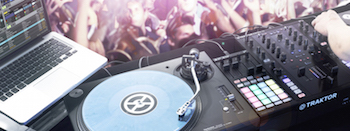
Department of
Computational Perception

 |
Department of
Computational Perception
|
 |
ARTISTIC APPLICATIONS
Music Production Technology and Creative Tools
| In the
context of music production and creation
— in a studio setting as well as
live on stage — a number of music understanding tasks need to be
perfomed in order to support the composer/performer, ranging from
search and annotation tasks to beat synchronization to automatic
variation and modification. Music information retrieval methods can be used in these processes to facilitate workflow and artistic expression. Examples for projects:
|
 credit: Native Instruments |
| When
travelling on a train and looking out of the window, the fleeting
impressions of the moving scenery and the composition of the passing
objects generate a piece of visual music with its own tempo and rhythm,
its own colours and harmonies. The project sound/tracks aims at
capturing these visual impressions and translates them into a musical
composition in real-time. The view out of the window is captured with a
camera and translated into instantaneously played back piano music. The
passing scenery can be considered the score of a musical composition
which is going to be interpreted based on outside conditions such as
weather and lighting, the speed of the train, and the quality of the
camera. Thus, every journey will produce a unique composition. More details, background, and example videos on the sound/tracks project page Examples for projects:
|
sound/tracks - Tunnel near
Mallnitz-Obervellach
|
Weltassoziator
| The
Weltassoziator is intended as a space that allows observation of
machine cognition and association. Aspects of the world's knowledge are
projected in the space, interact with each other, and organize
autonomously. The presence of the visitor and the visitor's current
focus of attention change priorities in concept association and
initiate an interaction between visitor and machine. This stimulates a
joint association process of human and artificial intelligence and
ultimately leads to an intervowen stream of thoughts. Examples for projects:
|
last edited by pk on Sep 29, 2015